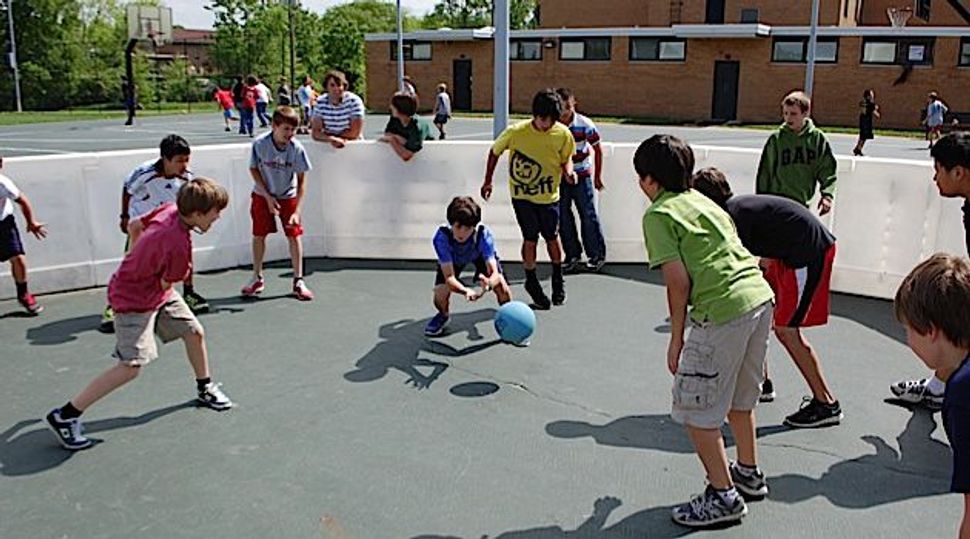Gaga Goes Mainstream as Israeli Dodgeball Game Becomes Fad

The Circle Game: Schoolchildren in Upper Arlington, Ohio, show their skills at Gaga, which means ?touch, touch? in Hebrew. Image by Courtesy Upper Arlington School District
For Jewish summer campers everywhere, “Lady” is not the first thing that “Gaga” brings to mind. Instead, Gaga is the name of an addictive game that provides a great workout — and that’s spreading from Jewish summer camps and day schools to the rest of America.
“You don’t lose the rush,” said Jenna Silverman, 12, of Waukegan, Ill. “It gets your heart rate up when you’re really into the game and usually jumping and dodging. It’s a lot of fun.”
Silverman may have a conflict of interest: Her father, Cliff Silverman, manufactures the pits in which the game is played. But these days, Gaga, a recreational staple at Jewish camps for decades, is even attracting adult adherents and becoming a burgeoning industry.
“When the sessions are done, kids are exhausted, drenched in sweat and get a great workout,” said Don Melnick, an instructor in the Israeli martial art krav magav who opened South Jersey GaGa in Cherry Hill, N.J., last July. “Parents are happy because it gets them off the couch, away from TV. Anyone can play. I don’t equate it as a Jewish sport or Jewish-only activity.”
Among counselors and parents, Gaga is regarded as a safer alternative to the popular playground game of dodgeball. The basic rules of Gaga dictate that a number of players open the game standing around an octagonal pit, usually constructed of wood or plastic. A ball is thrown into the middle of the pit and players then attempt to hit the ball at opponents below their waists. Once a player is hit below the waist, he or she is out until the next game. If the ball leaves the pit, the last player to touch it is out. The last player remaining is the winner. Games take no longer than five or 10 minutes.
There is no consensus on where the game began. “Ga, ga” translates to “touch, touch” in Hebrew.
“The word on the street was it was originally an Israeli game, although I haven’t met a whole lot [of Israelis] who are familiar with it,” said Aaron Greenberg, director at the JCC Camps at Medford in N.J.
Others have heard that the game originated at a camp in the Northeast and that Israeli counselors there brought the game back home. Or that the game started in Israel, but gained adherents in Australia.
Whatever its provenance, the formerly under-the-radar pastime is now played in leagues and tournaments at recreational centers and churches. Elementary schools from Washington to New Jersey are replacing jungle gyms with Gaga pits. At Harvard, Curry College and other colleges, students play outside Hillel houses. In Abilene, Texas, the graduating class of 2011 at McMurry University donated a Gaga pit as its class gift.
The game has even become a business opportunity in, of all places, the Upper East Side of Manhattan, where two friends founded The Gaga Center.
“People have this love for Gaga tucked away, and there are those who never heard of it before and fall in love the second they walk in the door,” said Alissa Schmelkin, who with her friend, Marcy Singer, opened an indoor facility with three Gaga pits last February.
Schmelkin had never played the game, but about six years ago her four-year-old son became enthralled with Gaga at Coleman Country Day Camp in Long Island. Singer, whose son went to Hampton Country Day Camp in Long Island, also came home singing its praises.
“We were talking and realized they loved the same game and we had never heard of it before,” Schmelkin said. “But there was no place in Manhattan to play.”
The emergence of Gaga has created a new market for entrepreneurs like Schmelkin, who is considering opening up additional Gaga centers across the city.
Chris Guertin, president of Sport Resource Group in Minneapolis, Minn., has been manufacturing Gaga pits since 2008. Guertin estimated he has sold 70 pits in 2012, more than double the sales of the previous year. Sport Resource Group’s pits are available in varying sizes and have been sold across the country in schools and camps. Guertin said that, on average, a pit costs $4,000 to $5,000.
Douglass Mann, an associate professor in the health and exercise science department at Rowan University in Glassboro, N.J., said Gaga helps children develop better skills in lateral movement and backward movement. Mann was first introduced to the game as a counselor at Tall Pines Day Camp in Williamstown, N.J., about seven years ago. He said the game has long been popular in the South Jersey region, but he has recently received an increase in calls and emails from parents, teachers and YMCA leaders from around the country who are interested in learning the game.
“There’s definitely a fitness element to Gaga,” said Melnick, co-owner of South Jersey GaGa. The game helps hand-eye coordination and trains children to be aware, he said, adding, “These kids are running around constantly, working out, moving, running, dodging, jumping. It’s a very physical game for these kids.”
Schmelkin thought one of the reasons Gaga’s popularity has increased was a decrease in the popularity of dodgeball as parents worry about children being hit in the head. In Gaga, the most common injury is “Gaga knuckles,” which can occur when the game is played with a heavier ball, and players hit it with a closed fist rather than an open hand, causing knuckles to scrape the ground.
Greenberg, of the JCC Camps at Medford in N.J., has yet to hear a parent complain about the game’s safety, which has been played at his site since the mid-1990s.
Of Gaga knuckles, he says, “It’s almost like a badge of pride for campers. Kids are proud to go to the nurse’s office with Gaga knuckles; it’s like an initiation.”
Contact Seth Berkman at [email protected]
A message from our Publisher & CEO Rachel Fishman Feddersen

I hope you appreciated this article. Before you go, I’d like to ask you to please support the Forward’s award-winning, nonprofit journalism during this critical time.
We’ve set a goal to raise $260,000 by December 31. That’s an ambitious goal, but one that will give us the resources we need to invest in the high quality news, opinion, analysis and cultural coverage that isn’t available anywhere else.
If you feel inspired to make an impact, now is the time to give something back. Join us as a member at your most generous level.
— Rachel Fishman Feddersen, Publisher and CEO























